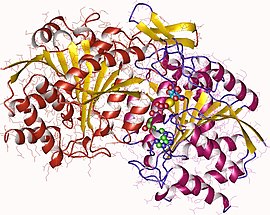Isocitrate dehydrogenase (NAD+)
| Isocitrate dehydrogenase (NAD+) | |||||||||
|---|---|---|---|---|---|---|---|---|---|
 isocitrate dehydrogenase [NAD] heterodimer, Human | |||||||||
| Identifiers | |||||||||
| EC no. | 1.1.1.41 | ||||||||
| CAS no. | 9001-58-5 | ||||||||
| Databases | |||||||||
| IntEnz | IntEnz view | ||||||||
| BRENDA | BRENDA entry | ||||||||
| ExPASy | NiceZyme view | ||||||||
| KEGG | KEGG entry | ||||||||
| MetaCyc | metabolic pathway | ||||||||
| PRIAM | profile | ||||||||
| PDB structures | RCSB PDB PDBe PDBsum | ||||||||
| |||||||||
Isocitrate dehydrogenase (NAD+) (EC 1.1.1.41, isocitric dehydrogenase, beta-ketoglutaric-isocitric carboxylase, isocitric acid dehydrogenase, NAD dependent isocitrate dehydrogenase, NAD isocitrate dehydrogenase, NAD-linked isocitrate dehydrogenase, NAD-specific isocitrate dehydrogenase, NAD isocitric dehydrogenase, isocitrate dehydrogenase (NAD), IDH (ambiguous), nicotinamide adenine dinucleotide isocitrate dehydrogenase) is an enzyme with systematic name isocitrate:NAD+ oxidoreductase (decarboxylating).[1][2][3][4][5][6][7] This enzyme catalyses the following chemical reaction
- isocitrate + NAD+ 2-oxoglutarate + CO2 + NADH
Requires Mn2+ or Mg2+ for activity. Unlike EC 1.1.1.42, isocitrate dehydrogenase (NADP+), oxalosuccinate cannot be used as a substrate. In eukaryotes, isocitrate dehydrogenase exists in two forms: an NAD+-linked enzyme found only in mitochondria and displaying allosteric properties, and a non-allosteric, NADP+-linked enzyme that is found in both mitochondria and cytoplasm. The enzyme from some species can also use NADP+ but much more slowly.[8][9]
References
- ^ Hathaway JA, Atkinson DE (August 1963). "The effect of adenylic acid on yeast nicotinamide adenine dinucleotide isocitrate dehydrogenase, a possible metabolic control mechanism". The Journal of Biological Chemistry. 238: 2875–81. PMID 14063317.
- ^ Kornberg A, Pricer WE (March 1951). "Di- and triphosphopyridine nucleotide isocitric dehydrogenases in yeast". The Journal of Biological Chemistry. 189 (1): 123–36. PMID 14832224.
- ^ Plaut GW, Lardy H, Myrbäck K (1963). "Isocitrate dehydrogenases". In Boyer PD (ed.). The Enzymes. Vol. 7 (2nd ed.). New York: Academic Press. pp. 105–126.
- ^ Plaut GW, Sung SC (March 1954). "Diphosphopyridine nucleotide isocitric dehydrogenase from animal tissues". The Journal of Biological Chemistry. 207 (1): 305–14. PMID 13152105.
- ^ Ramakrishnan CV, Martin SM (1955). "Isocitric dehydrogenase in Aspergillus niger". Arch. Biochem. Biophys. 55: 403–407. doi:10.1016/0003-9861(55)90421-5.
- ^ Vickery HB (June 1962). "A suggested new nomenclature for the isomers of isocitric acid". The Journal of Biological Chemistry. 237: 1739–41. PMID 13925783.
- ^ Camacho ML, Brown RA, Bonete MJ, Danson MJ, Hough DW (December 1995). "Isocitrate dehydrogenases from Haloferax volcanii and Sulfolobus solfataricus: enzyme purification, characterisation and N-terminal sequence". FEMS Microbiology Letters. 134 (1): 85–90. doi:10.1016/0378-1097(95)00388-l. PMID 8593959.
- ^ Kim YO, Koh HJ, Kim SH, Jo SH, Huh JW, Jeong KS, Lee IJ, Song BJ, Huh TL (December 1999). "Identification and functional characterization of a novel, tissue-specific NAD(+)-dependent isocitrate dehydrogenase beta subunit isoform". The Journal of Biological Chemistry. 274 (52): 36866–75. doi:10.1074/jbc.274.52.36866. PMID 10601238.
- ^ Inoue H, Tamura T, Ehara N, Nishito A, Nakayama Y, Maekawa M, Imada K, Tanaka H, Inagaki K (August 2002). "Biochemical and molecular characterization of the NAD(+)-dependent isocitrate dehydrogenase from the chemolithotroph Acidithiobacillus thiooxidans". FEMS Microbiology Letters. 214 (1): 127–32. doi:10.1016/s0378-1097(02)00857-1. PMID 12204383.
External links
- Isocitrate+dehydrogenase+(NAD+) at the U.S. National Library of Medicine Medical Subject Headings (MeSH)
